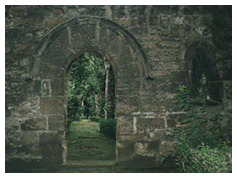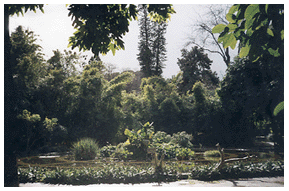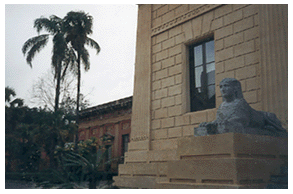Magazine
Best of Sicily
Arts &
Culture
Fashion
Food & Wine
History
& Culture
About
Us
Travel
Faqs
Contact
Map of Sicily
|
 |
 The Botanical Gardens (Orto Botanico) of Palermo are among the oldest modern centers for botanical studies in
the Mediterranean region. The park houses a greenhouse (glasshouse), seed
and dried plant repository, catalogue archive, and more than ten hectares
of outdoor gardens in the busy centre of what is today Sicily's largest
city. The Orto Botanico, bordering the Kalsa district, is home to hundreds of tropical and semi-tropical
plants from around the world, many of which were introduced into Europe
by this unique organisation, now administered by the University of Palermo.
The medieval kings of Sicily had vast gardens around the palaces known as
the Cuba and the Zisa, but in terms of modern botany, the Orto Botanical
was founded with eighteenth century biological principles in mind. The Royal
Academy of Studies, the university of its day, first established a botanical
institute at Palermo in 1779 under the auspices of the government of King
Francesco I of the Two Sicilies. Requiring more space, the Botanical Gardens
were transferred to their present location, next to the Villa Giulia park,
in 1786. The Neo-Classical structures visible today were begun three years
later, based on designs by Trombetta, Marabitti and the famous Venanzio
Marvuglia. The sculptor Vitale Tuccio created the two sphinxes flanking
the steps leading to the main building. These works have been recently restored.
One section of the gardens is arranged based on the Engler system, the other
on the Linnaean system. The Botanical Gardens (Orto Botanico) of Palermo are among the oldest modern centers for botanical studies in
the Mediterranean region. The park houses a greenhouse (glasshouse), seed
and dried plant repository, catalogue archive, and more than ten hectares
of outdoor gardens in the busy centre of what is today Sicily's largest
city. The Orto Botanico, bordering the Kalsa district, is home to hundreds of tropical and semi-tropical
plants from around the world, many of which were introduced into Europe
by this unique organisation, now administered by the University of Palermo.
The medieval kings of Sicily had vast gardens around the palaces known as
the Cuba and the Zisa, but in terms of modern botany, the Orto Botanical
was founded with eighteenth century biological principles in mind. The Royal
Academy of Studies, the university of its day, first established a botanical
institute at Palermo in 1779 under the auspices of the government of King
Francesco I of the Two Sicilies. Requiring more space, the Botanical Gardens
were transferred to their present location, next to the Villa Giulia park,
in 1786. The Neo-Classical structures visible today were begun three years
later, based on designs by Trombetta, Marabitti and the famous Venanzio
Marvuglia. The sculptor Vitale Tuccio created the two sphinxes flanking
the steps leading to the main building. These works have been recently restored.
One section of the gardens is arranged based on the Engler system, the other
on the Linnaean system.
The Orto Botanico has some pleasant surprises. The area was once part
of a park owned by the Crown, which used
it as a vineyard. Then it was claimed by the Diocese of Palermo, and the
ruins of an entrance and wall of the fourteenth century Church of Saint
Dennis are still visible in an isolated corner of the Gardens. The Baroque
greenhouse seen today was built in cast iron in the late nineteenth century,
replacing an older wooden one donated by Queen Maria Carolina of Naples
in 1806. by the Crown, which used
it as a vineyard. Then it was claimed by the Diocese of Palermo, and the
ruins of an entrance and wall of the fourteenth century Church of Saint
Dennis are still visible in an isolated corner of the Gardens. The Baroque
greenhouse seen today was built in cast iron in the late nineteenth century,
replacing an older wooden one donated by Queen Maria Carolina of Naples
in 1806.
The plants themselves include foreign species such as bamboo from Burma,
various foreign palms, the coffee plant, sycamore, manioc, papaya and many
others. Mandarins and loquats are also present, having been introduced into
the agriculture of the Mediterranean countries from the Far East by the
Palermo Botanical Gardens between 1812 and 1817 with specimens donated by
the British Royal Navy. Here you can also see cotton and sugar cane, once
widely cultivated in Sicily. In the Aquarium, a round, multi-tiered pond,
there are several species of lotus and water lily, including Oriental varieties.
The Orto Botanico also has a large cactus collection.
It's ambience is different from what you might expect in the newer botanical
gardens of other nations. Little consideration  seems to have been given to the aesthetic element of arborial areas.
In many respects, the Gardens reflect the look they had two centuries ago.
Many areas seem haphazardly assembled. Yet, this is precisely what gives
the Orto Botanico a slightly wild appearance so welcome in a Sicilian urban
park. If you seek symmetry, there's Villa Giulia next door. seems to have been given to the aesthetic element of arborial areas.
In many respects, the Gardens reflect the look they had two centuries ago.
Many areas seem haphazardly assembled. Yet, this is precisely what gives
the Orto Botanico a slightly wild appearance so welcome in a Sicilian urban
park. If you seek symmetry, there's Villa Giulia next door.
One of the more important roles of the Botanical Gardens is cataloging
the wild plants found in Sicily, and the University tracks the status and
conservation of these species. There's also a special area dedicated specifically
to Mediterranean species not present in Sicily. The Orto Botanico belongs
to a global network of botanical institutions which exchange seeds, specimens
and information.
The Botanical Gardens are an interesting place to visit on a hot Sicilian
day. Admission prices are nominal and the Gardens are open to the public
most weekdays from 9:00 AM until 1:00 PM, and from 9:00 AM until 5:00 PM
on Tuesdays and Thursdays. The main entrance is on Via Lincoln.
About the Author: Maria Mazzaro is a journalist who specialises in environmental subjects.
|

 The Botanical Gardens (Orto Botanico) of Palermo are among the oldest modern centers for botanical studies in
the Mediterranean region. The park houses a greenhouse (glasshouse), seed
and dried plant repository, catalogue archive, and more than ten hectares
of outdoor gardens in the busy centre of what is today Sicily's largest
city. The Orto Botanico, bordering the
The Botanical Gardens (Orto Botanico) of Palermo are among the oldest modern centers for botanical studies in
the Mediterranean region. The park houses a greenhouse (glasshouse), seed
and dried plant repository, catalogue archive, and more than ten hectares
of outdoor gardens in the busy centre of what is today Sicily's largest
city. The Orto Botanico, bordering the  by the Crown, which used
it as a vineyard. Then it was claimed by the Diocese of Palermo, and the
ruins of an entrance and wall of the fourteenth century Church of Saint
Dennis are still visible in an isolated corner of the Gardens. The Baroque
greenhouse seen today was built in cast iron in the late nineteenth century,
replacing an older wooden one donated by Queen Maria Carolina of Naples
in 1806.
by the Crown, which used
it as a vineyard. Then it was claimed by the Diocese of Palermo, and the
ruins of an entrance and wall of the fourteenth century Church of Saint
Dennis are still visible in an isolated corner of the Gardens. The Baroque
greenhouse seen today was built in cast iron in the late nineteenth century,
replacing an older wooden one donated by Queen Maria Carolina of Naples
in 1806. seems to have been given to the aesthetic element of arborial areas.
In many respects, the Gardens reflect the look they had two centuries ago.
Many areas seem haphazardly assembled. Yet, this is precisely what gives
the Orto Botanico a slightly wild appearance so welcome in a Sicilian urban
park. If you seek symmetry, there's Villa Giulia next door.
seems to have been given to the aesthetic element of arborial areas.
In many respects, the Gardens reflect the look they had two centuries ago.
Many areas seem haphazardly assembled. Yet, this is precisely what gives
the Orto Botanico a slightly wild appearance so welcome in a Sicilian urban
park. If you seek symmetry, there's Villa Giulia next door.